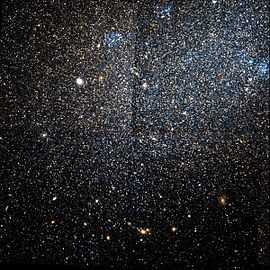Sextans B
| Sextans B | |
|---|---|
 | |
| Observation data (J2000 epoch) | |
| Constellation | Sextans |
| Right ascension | 10h 00m 00.1s[1] |
| Declination | +05° 19′ 56″[1] |
| Redshift | 300 ± 0 km/s[1] |
| Distance | 4.44 ± 0.23 Mly (1.36 ± 0.07 Mpc)[2][3] |
| Type | ImIV-V[1] |
| Apparent dimensions (V) | 5′.1 × 3′.5[1] |
| Apparent magnitude (V) | 11.9[1] |
| Other designations | |
| UGC 5373,[1] PGC 28913,[1] DDO 70,[1] Sex B[1] | |
Sextans B (also known as UGC 5373 and DDO 70) is an irregular galaxy that may be part of the Local Group, or lie just beyond it. Sextans B is 4.44 million light-years away from Earth and thus is one of most distant members of the Local Group, if it is indeed a member. It forms a pair with its neighbouring galaxy Sextans A.[4] It is a type Ir IV-V galaxy according to the galaxy morphological classification scheme.[5] Sextans B may also be gravitationally associated with the galaxies NGC 3109 and the Antlia Dwarf.[6]
Sextans B has a uniform stellar population,[7] but the interstellar medium in it may be inhomogeneous.[8] Its mass is estimated to be about 2 × 108 times the mass of the Sun, of which 5.5 × 107 is in the form of atomic hydrogen.[7] Star formation in the galaxy seems to have proceeded in distinct periods of low intensity, separated by shorter periods of no activity.[7] The existence of Cepheid variables in the galaxy implies that Sextans B contains at least some young stars.[5] The metallicity of Sextans B is rather low, with a value of approximately Z = 0.001.[7] Sextans B is receding from the Milky Way with a speed of approximately 300 kilometres per second (190 mi/s),[8] and probably lies just outside the edge of the Local Group, so as its neighbour Sextans A.[9]
Five planetary nebulae have been identified in Sextans B. It is one of the smallest galaxies in which planetary nebulae have been observed. These appear point-like and can be identified by their spectral emission lines.[10] It also contains a massive globular cluster.[11]
References
- ↑ 1.0 1.1 1.2 1.3 1.4 1.5 1.6 1.7 1.8 1.9 "NASA/IPAC Extragalactic Database". Results for Sex B. Retrieved 2006-12-13.
- ↑ I. D. Karachentsev; V. E. Karachentseva; W. K. Hutchmeier; D. I. Makarov (2004). "A Catalog of Neighboring Galaxies". Astronomical Journal 127 (4): 2031–2068. Bibcode:2004AJ....127.2031K. doi:10.1086/382905.
- ↑ Karachentsev, I. D.; Kashibadze, O. G. (2006). "Masses of the local group and of the M81 group estimated from distortions in the local velocity field". Astrophysics 49 (1): 3–18. Bibcode:2006Ap.....49....3K. doi:10.1007/s10511-006-0002-6.
- ↑ Sandage, Allan; Carlson, George (July 1985). "The brightest stars in nearby galaxies. V – Cepheids and the brightest stars in the dwarf galaxy Sextans B compared with those in Sextans A". Astronomical Journal 90: 1019–1026. Bibcode:1985AJ.....90.1019S. doi:10.1086/113809.
- ↑ 5.0 5.1 van den bergh, Sidney (2000). The galaxies of the Local Group. University of Cambridge. p. 265. ISBN 978-0-521-65181-3.
- ↑ van den Bergh, Sidney (1999). "Stellar Content of Local Group Galaxies – An Introduction". The stellar content of Local Group galaxies 192: 3. Bibcode:1999IAUS..192....3V.
- ↑ 7.0 7.1 7.2 7.3 Tosi, M; Greggio, L.; Marconi, G.; Focardi, P. (September 1991). "Star formation in dwarf irregular galaxies – Sextans B". Astronomical Journal 102: 951–974. Bibcode:1991AJ....102..951T. doi:10.1086/115925.
- ↑ 8.0 8.1 Kniazev, Alexei Y.; Grebel, Eva K.; Pustilnik, Simon A.; Pramskij, Alexander G.; Zucker, Daniel B. (October 2005). "Spectrophotometry of Sextans A and B: Chemical Abundances of H II Regions and Planetary Nebulae". Astronomical Journal 130 (4): 1558–1573. arXiv:astro-ph/0502562. Bibcode:2005AJ....130.1558K. doi:10.1086/432931. Retrieved 2010-11-28.
- ↑ Alloin, Danielle M.; Gieren, Wolfgang (2000). Stellar candles for the extragalactic distance scale. University of Cambridge. p. 265. ISBN 978-3-540-20128-1.
- ↑ Magrini, L.; Corradi, R.L.M.; Walton, N.A.; Zijlstra, A.A.; Pollaco, D.L.; Walsh, J.R.; Perinotto, M.; Lennon, D.J.; Greimel, R. "The Local Group Census: planetary nebulae in Sextans B". Retrieved 2010-11-28.
- ↑ Sharina, M.E.; Puzia, T. H.; Krylatyh, A. S. (September 2009). "A Globular Cluster in Sextans B". Astronomy and Astrophysics 62 (3): 209–216. arXiv:0704.3908. Bibcode:2007AstBu..62..209S. doi:10.1134/S1990341307030029.
External links
- Sextans B on WikiSky: DSS2, SDSS, GALEX, IRAS, Hydrogen α, X-Ray, Astrophoto, Sky Map, Articles and images